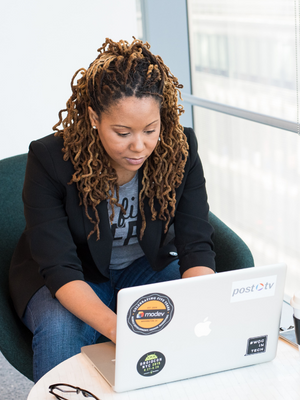 Informal sponsorship and mentorship can proliferate inequitable power dynamics in organizations. Organic sponsorship is a big part of how leadership proactively recasts the pipeline in the majority image. Meanwhile, the status quo power dynamic inhibits individuals who are in the minority among leadership from lifting others up behind them.
Informal sponsorship and mentorship can proliferate inequitable power dynamics in organizations. Organic sponsorship is a big part of how leadership proactively recasts the pipeline in the majority image. Meanwhile, the status quo power dynamic inhibits individuals who are in the minority among leadership from lifting others up behind them.
(This contribution from Pulsely dives into how informal sponsorship works to reinforce the glass ceiling).
Here’s one core way in which your organization is perpetuating inequitable power dynamics at senior levels: informal sponsorship and mentorship.
When you connect the dots of power, organic sponsorship is a big part of how leadership proactively, repetitively, and, by default, recasts the pipeline in the majority image. Meanwhile, the status quo power dynamic inhibits individuals who are in the minority among leadership from lifting others up behind them.
We offer a six point case for why leadership inclusion requires formal sponsorship programs that are deliberately disruptive in creating more equitable opportunities.
Mentorship and Sponsorship – What It Really Means
When it comes to career advancement, mentorship is both necessary and not enough. The common distinction is: a mentor talks with you, a sponsor talks about you.
A mentorship is 1-1. Mentors help you within your journey. They help you to navigate the intersection of your goals and career choices, identify and amplify strengths, and develop in core areas. Mentorship often acts as a trustworthy mirror for personal growth.
A sponsorship is more than 1-1. A sponsor relationship is 1-1+ an audience of power. Sponsors put skin and reputation in the game by leveraging their social capital (influence) in rooms you’ve yet to enter, and advocate for opportunities and advancement for you among their peers. The protégé also has the motivation of stepping up to the challenge because the sponsor’s reputation is on the line, too. Sponsorship often acts as a spotlight that shines on you to lift you up to the next level of career advancement.
As written by Rosalind Chow in Harvard Business Review, “Sponsorship can be understood as a form of intermediated impression management, where sponsors act as brand managers and publicists for their protégés. This work involves the management of others’ views on the sponsored employee. Thus, the relationship at the heart of sponsorship is not between protégés and sponsors, as is often thought, but between sponsors and an audience — the people they mean to sway to the side of their protégés.”
Why Informal Mentorship and Sponsorship Are Inequitable
“Regardless of education, motivation, and personal and professional success factors, being sponsored by a white man remains the primary accelerant to the career mobility of Black women.” (Stephanie Bradley Smith in HBR)
As this quote underlines, and Catalyst iterates in Sponsoring Women to Success, “Sponsorship is focused on advancement and predicated on power.”
The dynamic of organic sponsorship is ultimately majority promoting majority, with the same repeated outcome at leadership, save minor and temporary shifts. Even the common phrase of “winning sponsorship” has a blinding and dubious premise.
While data from different surveys inevitably differs on absolutes (for example, the % of people who report they have a sponsor is highly contextual to the criteria), what remains steady across studies is a debilitating power gap between individuals of the majority and non-majority when it comes to both sponsorship and who they are sponsored by.
Here’s what reproduces the current senior management and leadership profile:
1. Mentorship and especially executive sponsorship have a catalytic impact on career advancement for both protégés and sponsors.
- Male managers with sponsorship are 23% more likely (female managers with sponsorship are 19% more likely) to progress to the next rung of the career ladder than peers who do not have sponsors.
- Managers and executives who sponsor high-achieving junior talent are 53% more likely to advance to the next leadership level relative to peers who don’t sponsor.
2. Access to mentorship and executive sponsorship is highly variable depending on who you are, regardless of performance = inequitable.
- Professionals of color are nearly 40% less likely to report having a sponsor.
- According to one study, only 5% of up-and-coming Black employees are sponsored compared to 20% of their white peers.
- 41% of Hispanic U.S. executives say they benefited from formal mentoring or training but only a quarter of junior managers report access to mentoring programs.
- Black women professionals are least likely to have a substantive interaction with a senior leader—41% never have, versus 27% for all men and 33% for all women.
3. Mentorship and sponsorship are especially necessary to advance women and people of color.
- Black managers are 65% more likely to progress to the next rung in the ladder if they have a sponsor.
- Mentorship programs increase representation of Black, Hispanic, and Asian-American women, and Hispanic and Asian-American men, by 9% to 24%.
- Having mentors and sponsors who advocated for them is the single attribute shared by people of color who have progressed furthest in the leadership ranks.
- Executive sponsorship has been proven to be the most effective organizational intervention to advance Black talent.
- Latina women with sponsorship earn 6.1% more than peers who lack sponsors and black women earn 5.1% more.
4. But people tend to mentor and sponsor those just like them – and this means the majority (with the power) mostly sponsors the majority.
- 61% of people indicate their mentorship developed naturally.
- As much as 91% of white managers have no Black, Asian, or Latinx people in their immediate social network.
- 71% of sponsors report their protégé is the same race or gender as their own.
- 58% of women and 54% of men who sponsor choose a protégé because they “make me feel comfortable.”
- A study of 72 protégés found that 100% of sponsors of white male protégés were men and the majority (73.5%) were white. Among Black female protégés, most sponsors were Black (57%) and 27% were women.
- Payscale found 77.1 percent of male protégés said they had a male sponsor while women were about half as likely to have a male sponsor.
- Payscale found 90% of white men and women protégés reported they had a white sponsor, while Blacks and Hispanics were 35% less likely to.
5. Not only are there far fewer female and minority senior leaders, but increased personal career risk can hinder their sponsoring.
- Women hold only 1/4 of executive roles in the 1000 largest companies and BIPOCs make up only 17% of the C-suite.
- Despite a desire and even a higher sense of obligation to lift others of similar sex/gender up (26% for Black leaders vs. 20% for Hispanic and Asian and 7% for Caucasian), Black senior leaders face higher scrutiny and are 26% less likely to commit to being a sponsor than white executives.
- More than one third of black leaders report they never sponsor a junior talent who looks like them – despite often wanting to, at tension with personal career risk.
6. To further the gap, white and male sponsors hold more influence on outcomes of their protégé’s employment than those from the non-majority groups.
- In U.S. law firms and among lawyers who had sponsorship, white men were half as likely (30%) as women of color (62%) to feel that the lack of an influential mentor was a barrier to their advancement.
- Payscale found: black women with black sponsors are paid 11.3% less than black women with white sponsors; Hispanic women with Hispanic sponsors make 15.5% less than those with white sponsors; women with women sponsors make 14.6% less than those with male sponsors, and even men with female sponsors make 8.7% less than those with male sponsors. Payscale notes the gaps shrink after compensable factors are weighed in, but the gap remains.
If you want to introduce more equity into talent development, you cannot look away from the affinity bias-based pattern of those with high social capital using that power and influence to promote those who look like them into power, too, while also further advancing their own status. Nor can you look away from how the non-majority individuals who break through to leadership are inhibited from doing the same.
Formal mentorship and sponsorship programs are about deliberately disrupting the cycle of inequitable talent development that has strongly influenced your management and leadership to date. In the next article, we explore how in more detail.
Guest contribution: Originally published on the Pulsely blog, written by Aimee Hansen. Pulsely delivers diversity and inclusion diagnostics and actionable DEI insights to drive inclusion, equity, and performance. Pulsely’s scientific framework combines the power of understanding four key drivers of inclusion: diversity data, workplace inclusion, inclusion competencies, and performance indicators. To learn more, visit Pulsely, read an interview with Co-Founder Betsy Bagley, or check out the Pulsely blog to find more content like this.



